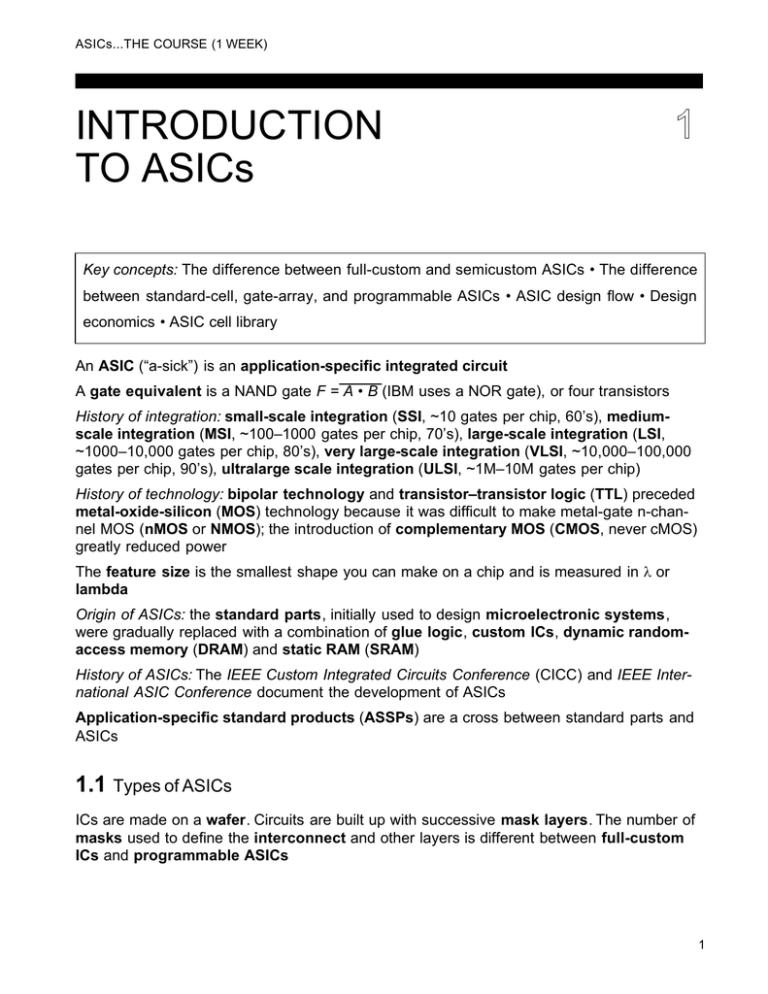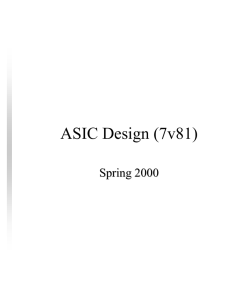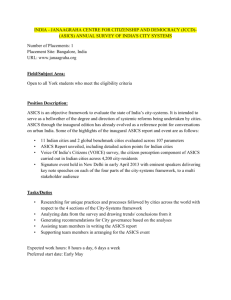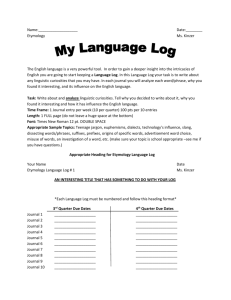INTRODUCTION TO ASICs 1
advertisement

ASICs...THE COURSE (1 WEEK) INTRODUCTION TO ASICs 1 Key concepts: The difference between full-custom and semicustom ASICs • The difference between standard-cell, gate-array, and programmable ASICs • ASIC design flow • Design economics • ASIC cell library An ASIC (“a-sick”) is an application-specific integrated circuit A gate equivalent is a NAND gate F = A • B (IBM uses a NOR gate), or four transistors History of integration: small-scale integration (SSI, ~10 gates per chip, 60’s), mediumscale integration (MSI, ~100–1000 gates per chip, 70’s), large-scale integration (LSI, ~1000–10,000 gates per chip, 80’s), very large-scale integration (VLSI, ~10,000–100,000 gates per chip, 90’s), ultralarge scale integration (ULSI, ~1M–10M gates per chip) History of technology: bipolar technology and transistor–transistor logic (TTL) preceded metal-oxide-silicon (MOS) technology because it was difficult to make metal-gate n-channel MOS (nMOS or NMOS); the introduction of complementary MOS (CMOS, never cMOS) greatly reduced power The feature size is the smallest shape you can make on a chip and is measured in λ or lambda Origin of ASICs: the standard parts, initially used to design microelectronic systems, were gradually replaced with a combination of glue logic, custom ICs, dynamic randomaccess memory (DRAM) and static RAM (SRAM) History of ASICs: The IEEE Custom Integrated Circuits Conference (CICC) and IEEE International ASIC Conference document the development of ASICs Application-specific standard products (ASSPs) are a cross between standard parts and ASICs 1.1 Types of ASICs ICs are made on a wafer. Circuits are built up with successive mask layers. The number of masks used to define the interconnect and other layers is different between full-custom ICs and programmable ASICs 1 2 SECTION 1 INTRODUCTION TO ASICs ASICS... THE COURSE silicon die A silicon chip or integrated cicuit (IC) is more properly called a die 0.1 inch (a) (b) 1.1.1 Full-Custom ASICs All mask layers are customized in a full-custom ASIC. It only makes sense to design a full-custom IC if there are no libraries available. Full-custom offers the highest performance and lowest part cost (smallest die size) with the disadvantages of increased design time, complexity, design expense, and highest risk. Microprocessors were exclusively full-custom, but designers are increasingly turning to semicustom ASIC techniques in this area too. Other examples of full-custom ICs or ASICs are requirements for high-voltage (automobile), analog/digital (communications), or sensors and actuators. 1.1.2 Standard-Cell–Based ASICs A cell-based ASIC (CBIC—“sea-bick”) • Standard cells • Possibly megacells, megafunctions, fullcustom blocks, system-level macros (SLMs), fixed blocks, cores, or Functional Standard Blocks (FSBs) • All mask layers are customized—transistors and interconnect • Custom blocks can be embedded • Manufacturing lead time is about eight weeks. standard-cell area 1 2 3 fixed blocks 4 5 0.02in 500 µm In datapath (DP) logic we may use a datapath compiler and a datapath library. Cells such as arithmetic and logical units (ALUs) are pitch-matchedto each other to improve timing and density. ASICs... THE COURSE 1.1 Types of ASICs VDD m1 cell bounding box (BB) n-well contact ndiff pdiff Z A1 B1 via metal2 poly ndiff cell abutment box (AB) p-well pdiff pdiff GND 10λ Looking down on the layout of a standard cell from a standard-cell library 1.1.3 Gate-Array–Based ASICs A gate array, masked gate array, MGA, or prediffused array uses macros (books) to reduce turnaround time and comprises a base array made from a base cell or primitive cell. There are three types: • Channeled gate arrays • Channelless gate arrays • Structured gate arrays 3 4 SECTION 1 INTRODUCTION TO ASICs 1 ASICS... THE COURSE expanded view of part of flexible block 1 250 λ terminal no connection connection metal2 to power pads VSS VDD to power pads metal1 VSS VDD Z feedthrough row-end cells cell A.11 cell A.14 cell A.23 cell A.132 metal2 I1 metal1 spacer cells metal2 power cell metal1 rows of standard cells 50 λ Routing a CBIC (cell-based IC) • A “wall” of standard cells forms a flexible block • metal2 may be used in a feedthrough cell to cross over cell rows that use metal1 for wiring • Other wiring cells: spacer cells, row-end cells, and power cells A note on the use of hyphens and dashes in the spelling (orthography) of compound nouns: Be careful to distinguish between a “high-school girl” (a girl of high-school age) and a “high school girl” (is she on drugs or perhaps very tall?). We write “channeled gate array,” but “channeled gate-array architecture” because the gate array is channeled; it is not “channeled-gate array architecture” (which is an array of channeled-gates) or “channeled gate array architecture” (which is ambiguous). We write gate-array–based ASICs (with a en-dash between array and based) to mean (gate array)-based ASICs. ASICs... THE COURSE 1.1 Types of ASICs 1.1.4 Channeled Gate Array A channeled gate array base cell • Only the interconnect is customized • The interconnect uses predefined spaces between rows of base cells • Manufacturing lead time is between two days and two weeks array of base cells (not all shown) 1.1.5 Channelless Gate Array base cell A channelless gate array (channel-free gate array, seaof-gates array, or SOG array) • Only some (the top few) mask layers are customized— the interconnect • Manufacturing lead time is between two days and two weeks. 1.1.6 Structured Gate Array array of base cells (not all shown) 5 6 SECTION 1 INTRODUCTION TO ASICs An embedded gate array or structured gate array (masterslice or masterimage) ASICS... THE COURSE embedded block • Only the interconnect is customized • Custom blocks (the same for each design) can be embedded array of base cells (not all shown) • Manufacturing lead time is between two days and two weeks. 1.1.7 Programmable Logic Devices Examples and types of PLDs: read-only memory (ROM) • programmable ROM or PROM • electrically programmable ROM, or EPROM • An erasable PLD (EPLD) • electrically erasable PROM, or EEPROM • UV-erasable PROM, or UVPROM • mask-programmable ROM • A mask-programmed PLD usually uses bipolar technology Logic arrays may be either a Programmable Array Logic (PAL®, a registered trademark of AMD) or a programmable logic array (PLA); both have an AND plane and an OR plane A programmable logic device (PLD) • No customized mask layers or logic cells • Fast design turnaround macrocell • A single large block of programmable interconnect • A matrix of logic macrocells that usually consist of programmable array logic followed by a flip-flop or latch programmable interconnect ASICs... THE COURSE 1.2 Design Flow 7 1.1.8 Field-Programmable Gate Arrays A field-programmable gate array (FPGA) or complex PLD • None of the mask layers are customized • A method for programming the basic logic cells and the interconnect programmable basic logic cell • The core is a regular array of programmable basic logic cells that can implement combinational as well as sequential logic (flip-flops) • A matrix of programmable interconnect surrounds the basic logic cells • Programmable I/O cells surround the core programmable interconnect • Design turnaround is a few hours 1.2 Design Flow A design flow is a sequence of steps to design an ASIC 1. Design entry. Using a hardware description language (HDL) or schematic entry. 2. Logic synthesis. Produces a netlist—logic cells and their connections. 3. System partitioning. Divide a large system into ASIC-sized pieces. 4. Prelayout simulation. Check to see if the design functions correctly. 5. Floorplanning. Arrange the blocks of the netlist on the chip. 6. Placement. Decide the locations of cells in a block. 7. Routing. Make the connections between cells and blocks. 8. Extraction. Determine the resistance and capacitance of the interconnect. 9. Postlayout simulation. Check to see the design still works with the added loads of the interconnect. 1.3 Case Study SPARCstation 1: Better performance at lower cost • Compact size, reduced power, and quiet operation • Reduced number of parts, easier assembly, and improved reliability 8 SECTION 1 INTRODUCTION TO ASICs ASICS... THE COURSE start prelayout simulation logical design design entry 4 1 VHDL/Verilog logic synthesis netlist 2 A system partitioning B 3 A postlayout simulation floorplanning 9 5 chip placement 6 circuit extraction block physical design routing 8 back-annotated netlist 7 logic cells finish ASIC design flow. Steps 1–4 are logical design, and steps 5–9 are physical design The ASICs in the Sun Microsystems SPARCstation 1 1 2 3 4 5 6 7 8 9 SPARCstation 1 ASIC SPARC integer unit (IU) SPARC floating-point unit (FPU) Cache controller Memory-management unit (MMU) Data buffer Direct memory access (DMA) controller Video controller/data buffer RAM controller Clock generator Gates (k-gates) 20 50 9 5 3 9 4 1 1 ASICs... THE COURSE 1.4 Economics of ASICs The CAD tools used in the design of the Sun Microsystems SPARCstation 1 Design level ASIC design Board design Mechanical design Management Function ASIC physical design ASIC logic synthesis ASIC simulation Schematic capture PCB layout Timing verification Case and enclosure Thermal analysis Structural analysis Scheduling Documentation Tool LSI Logic Internal tools and UC Berkeley tools LSI Logic Valid Logic Valid Logic Allegro Quad Design Motive and internal tools Autocad Pacific Numerix Cosmos Suntrac Interleaf and FrameMaker 1.4 Economics of ASICs We’ll compare the most popular types of ASICs: an FPGA, an MGA, and a CBIC. The figures in the following sections are approximate and used to illustrate the different components of cost. 1.4.1 Comparison Between ASIC Technologies Example of an ASIC part cost: A 0.5 µm, 20k-gate array might cost 0.01–0.02 cents/gate (for more than 10,000 parts) or $2–$4 per part, but an equivalent FPGA might be $20. When does it make sense to use a more expensive part? This is what we shall examine next. 9 10 SECTION 1 INTRODUCTION TO ASICs ASICS... THE COURSE 1.4.2 Product Cost In a product cost there are fixed costs and variable costs (the number of products sold is the sales volume): total product cost = fixed product cost + variable product cost × products sold In a product made from parts the total cost for any part is total part cost = fixed part cost + variable cost per part × volume of parts For example, suppose we have the following (imaginary) costs: • FPGA: $21,800 (fixed) $39 (variable) • MGA: $86,000 (fixed) $10 (variable) • CBIC $146,000 (fixed) $8 (variable) Then we can calculate the following break-even volumes: • FPGA/MGA ≈ 2000 parts • FPGA/CBIC ≈ 4000 parts • MGA/CBIC ≈ 20,000 parts cost of parts $1,000,000 break-even FPGA/CBIC CBIC $100,000 MGA FPGA break-even MGA/CBIC break-even FPGA/MGA $10,000 10 100 1000 10,000 100,000 number of parts or volume Break-even graph ASICs... THE COURSE 1.4 Economics of ASICs 11 1.4.3 ASIC Fixed Costs Examples of fixed costs: training cost for a new electronic design automation (EDA) system • hardware and software cost • productivity • production test and design for test • programming costs for an FPGA • nonrecurring-engineering (NRE) • test vectors and test-program development cost • pass (turn or spin) • profit model represents the profit flow during the product lifetime • product velocity • second source Training: Days Cost/day Hardware Software Design: Size (gates) Gates/day Days Cost/day Design for test: Days Cost/day NRE: Masks Simulation Test program Second source: Days Cost/day Total fixed costs Spreadsheet, “Fixed Costs” FPGA $800 MGA $2,000 2 $400 $10,000 $1,000 $8,000 CBIC $2,000 5 $400 $10,000 $20,000 $20,000 10,000 500 20 $400 5 $400 $10,000 $40,000 $20,000 10,000 200 50 $400 $2,000 10,000 200 50 $400 $2,000 5 $400 $30,000 5 $400 $70,000 $10,000 $10,000 $10,000 $2,000 $2,000 5 $400 $21,800 $50,000 $10,000 $10,000 $2,000 5 $400 $86,000 5 $400 $146,000 12 SECTION 1 INTRODUCTION TO ASICs sales per quarter, s ASICS... THE COURSE peak sales s1 $20M lost sales product introduction $10M end of product life s2 t1 Profit model Q1 Q2 Q3 Q4 t2 delay to market, d Q1 Q2 t3 time ASICs... THE COURSE 1.4 Economics of ASICs 13 1.4.4 ASIC Variable Costs Factors affecting fixed costs: wafer size • wafer cost • Moore’s Law (Gordon Moore of Intel) • gate density • gate utilization • die size • die per wafer • defect density • yield • die cost • profit margin (depends on fab or fabless) • price per gate • part cost FPGA Wafer size Wafer cost Design Density Utilization Die size Die/wafer Defect density Yield Die cost Profit margin Price/gate Part cost Spreadsheet, “Variable Costs” MGA 6 1,400 10,000 10,000 60 1.67 88 1.10 65 25 60 0.39 $39 CBIC 6 1,300 10,000 20,000 85 0.59 248 0.90 72 7 45 0.10 $10 6 1,500 10,000 25,000 100 0.40 365 1.00 80 5 50 0.08 $8 Units inches $ gates gates/sq.cm % sq.cm defects/sq.cm % $ % cents 14 SECTION 1 INTRODUCTION TO ASICs ASICS... THE COURSE cents/gate 1.00 CBIC 2 µm CBIC 1.5 µm CBIC 1 µm 0.10 CBIC 0.6 µm FPGA 1 µm FPGA 0.6 µm –32%/year 0.01 1984 1986 Example price per gate figures 1988 1990 1992 1994 1996 ASICs... THE COURSE 1.5 ASIC Cell Libraries 15 1.5 ASIC Cell Libraries You can: (1) use a design kit from the ASIC vendor (2) buy an ASIC-vendor library from a library vendor (3) you can build your own cell library (1) is usually a phantom library—the cells are empty boxes, or phantoms, you hand off your design to the ASIC vendor and they perform phantom instantiation (Synopsys CBA) (2) involves a buy-or-build decision. You need a qualified cell library (qualified by the ASIC foundry) If you own the masks (the tooling) you have a customer-owned tooling (COT, pronounced “see-oh-tee”) solution (which is becoming very popular) (3) involves a complex library development process: cell layout • behavioral model • Verilog/VHDL model • timing model • test strategy • characterization • circuit extraction • process control monitors (PCMs) or drop-ins • cell schematic • cell icon • layout versus schematic (LVS) check • cell icon • logic synthesis • retargeting • wire-load model • routing model • phantom 16 SECTION 1 INTRODUCTION TO ASICs ASICS... THE COURSE 1.6 Summary Key concepts: • We could define an ASIC as a design style that uses a cell library • The difference between full-custom and semicustom ASICs • The difference between standard-cell, gate-array, and programmable ASICs • The ASIC design flow • Design economics including part cost, NRE, and breakeven volume • The contents and use of an ASIC cell library Types of ASIC ASIC type Full-custom Semicustom Programmable Family member Analog/digital Cell-based (CBIC) Masked gate array (MGA) Field-programmable gate array (FPGA) Programmable logic device (PLD) Custom mask layers All All Some None None Custom logic cells Some None None None None 1.7 Problems Suggested homework: 1.4, 1.5, 1.9 (from ASICs... the book) 1.8 Bibliography EE Times (ISSN 0192-1541, http://techweb.cmp.com/eet), EDN (ISSN 0012-7515, http://www.ednmag.com), EDAC (Electronic Design Automation Companies) (http://www.edac.org), The Electrical Engineering page on the World Wide Web (E2W3) (http://www.e2w3.com), SEMATECH (Semiconductor Manufacturing Technology) (http://www.sematech.org), The MIT Semiconductor Subway (http://wwwmtl.mit.edu), EDA companies at http://www.yahoo.comunder Business_and_Economyin Companies/Computers/Software/Graphics/CAD/IC_Design, The MOS Implementation Service (MOSIS) (http://www.isi.edu), The Microelectronic Systems Newsletter at http://wwwece.engr.utk.edu/ece, NASA (http://nppp.jpl.nasa.gov/dmg/jpl/loc/asic ) ASICs... THE COURSE 1.9 References 17 1.9 References Glasser, L. A., and D. W. Dobberpuhl. 1985. The Design and Analysis of VLSI Circuits. Reading, MA: Addison-Wesley, 473 p. ISBN 0-201-12580-3. TK7874.G573. Detailed analysis of circuits, but largely nMOS. Mead, C. A., and L. A. Conway. 1980. Introduction to VLSI Systems. Reading, MA: AddisonWesley, 396 p. ISBN 0-201-04358-0. TK7874.M37. Weste, N. H. E., and K. Eshraghian. 1993. Principles of CMOS VLSI Design: A Systems Perspective. 2nd ed. Reading, MA: Addison-Wesley, 713 p. ISBN 0-201-53376-6. TK7874.W46. Concentrates on full-custom design. 18 SECTION 1 INTRODUCTION TO ASICs ASICS... THE COURSE



